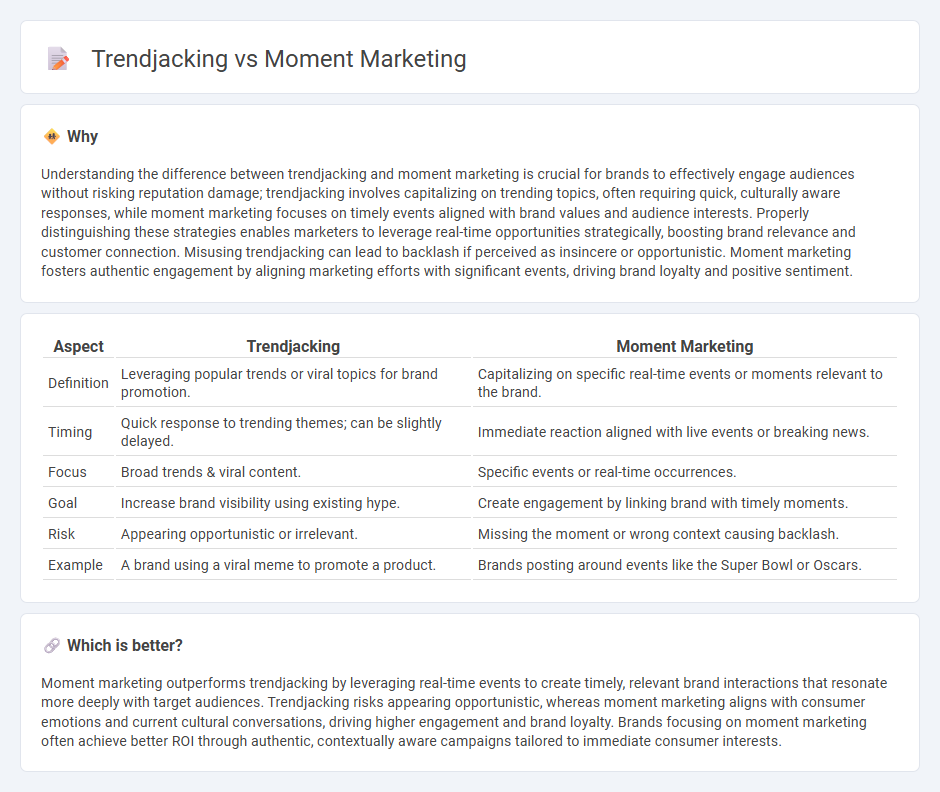
Trendjacking leverages viral topics to swiftly align a brand with current conversations, enhancing visibility and engagement. Moment marketing focuses on real-time events or cultural moments to create timely, relevant campaigns that resonate deeply with target audiences. Explore more strategies to effectively capture consumer attention through dynamic marketing approaches.
Why it is important
Understanding the difference between trendjacking and moment marketing is crucial for brands to effectively engage audiences without risking reputation damage; trendjacking involves capitalizing on trending topics, often requiring quick, culturally aware responses, while moment marketing focuses on timely events aligned with brand values and audience interests. Properly distinguishing these strategies enables marketers to leverage real-time opportunities strategically, boosting brand relevance and customer connection. Misusing trendjacking can lead to backlash if perceived as insincere or opportunistic. Moment marketing fosters authentic engagement by aligning marketing efforts with significant events, driving brand loyalty and positive sentiment.
Comparison Table
| Aspect | Trendjacking | Moment Marketing |
|---|---|---|
| Definition | Leveraging popular trends or viral topics for brand promotion. | Capitalizing on specific real-time events or moments relevant to the brand. |
| Timing | Quick response to trending themes; can be slightly delayed. | Immediate reaction aligned with live events or breaking news. |
| Focus | Broad trends & viral content. | Specific events or real-time occurrences. |
| Goal | Increase brand visibility using existing hype. | Create engagement by linking brand with timely moments. |
| Risk | Appearing opportunistic or irrelevant. | Missing the moment or wrong context causing backlash. |
| Example | A brand using a viral meme to promote a product. | Brands posting around events like the Super Bowl or Oscars. |
Which is better?
Moment marketing outperforms trendjacking by leveraging real-time events to create timely, relevant brand interactions that resonate more deeply with target audiences. Trendjacking risks appearing opportunistic, whereas moment marketing aligns with consumer emotions and current cultural conversations, driving higher engagement and brand loyalty. Brands focusing on moment marketing often achieve better ROI through authentic, contextually aware campaigns tailored to immediate consumer interests.
Connection
Trendjacking and moment marketing are interconnected strategies that leverage current events and viral trends to boost brand visibility and engagement. Trendjacking involves capitalizing on popular cultural moments or trending topics to insert a brand's message, while moment marketing focuses on real-time campaigns aligned with specific occasions or breaking news. Both approaches require timely execution and deep audience understanding to maximize relevance and impact in a competitive digital landscape.
Key Terms
**Moment Marketing:**
Moment marketing leverages real-time events and cultural moments to create relevant and timely brand messages that resonate with current audience interests. It emphasizes authenticity and immediate engagement, aligning campaigns with ongoing occurrences to boost brand visibility and consumer connection. Discover effective strategies to harness moment marketing for impactful brand communication.
Real-time engagement
Moment marketing capitalizes on real-time events by aligning brand messages with timely, relevant occurrences to engage audiences instantly. Trendjacking involves seizing popular trends or viral content to amplify brand visibility and connect with a broader audience in the moment. Explore how integrating moment marketing and trendjacking strategies can boost real-time engagement and drive impactful consumer interactions.
Contextual relevance
Moment marketing leverages real-time events to create timely, relevant campaigns that resonate with current audience sentiments, while trendjacking involves capitalizing on popular trends, often unrelated to a brand's core message, to gain visibility. The key distinction lies in contextual relevance, where moment marketing aligns closely with the immediate environment and consumer mindset, enhancing authenticity and engagement. Explore how mastering contextual relevance in both strategies can boost your brand's impact and resonance.
Source and External Links
5 Ways to Boost Your Brand Engagement with Moment Marketing - Moment marketing is a strategy where brands leverage current trends, news, or events to deliver timely messages that boost brand awareness and sales, requiring readiness and creativity to capitalize on trending conversations effectively.
What we know about moment marketing - WARC - Moment marketing focuses on delivering the right message to the right consumer at the perfect time using real-time data and programmatic technology to enhance engagement and purchasing opportunities.
Moment Marketing: 10 Examples & Case Studies You Need To Know - This marketing tactic increases engagement, reach, customer loyalty, and ROI by creatively tapping into timely cultural events and trends, allowing brands flexibility and emotional connection with consumers.
 dowidth.com
dowidth.com